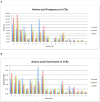Low complexity regions in the proteins of prokaryotes perform important functional roles and are highly conserved
- PMID: 31504783
- PMCID: PMC6821194
- DOI: 10.1093/nar/gkz730
Low complexity regions in the proteins of prokaryotes perform important functional roles and are highly conserved
Abstract
We provide the first high-throughput analysis of the properties and functional role of Low Complexity Regions (LCRs) in more than 1500 prokaryotic and phage proteomes. We observe that, contrary to a widespread belief based on older and sparse data, LCRs actually have a significant, persistent and highly conserved presence and role in many and diverse prokaryotes. Their specific amino acid content is linked to proteins with certain molecular functions, such as the binding of RNA, DNA, metal-ions and polysaccharides. In addition, LCRs have been repeatedly identified in very ancient, and usually highly expressed proteins of the translation machinery. At last, based on the amino acid content enriched in certain categories, we have developed a neural network web server to identify LCRs and accurately predict whether they can bind nucleic acids, metal-ions or are involved in chaperone functions. An evaluation of the tool showed that it is highly accurate for eukaryotic proteins as well.
© The Author(s) 2019. Published by Oxford University Press on behalf of Nucleic Acids Research.
Figures
References
-
- Wootton J.C. Non-globular domains in protein sequences: automated segmentation using complexity measures. Comput. Chem. 1994; 18:269–285. - PubMed
-
- Wootton J.C., Drummond M.H.. The Q-linker: a class of interdomain sequences found in bacterial multidomain regulatory proteins. Protein. Eng. 1989; 2:535–543. - PubMed
-
- Huntley M.A., Golding G.B.. Simple sequences are rare in the Protein Data Bank. Proteins. 2002; 48:134–140. - PubMed
-
- Altschul S.F., Gish W., Miller W., Myers E.W., Lipman D.J.. Basic local alignment search tool. J. Mol. Biol. 1990; 215:403–410. - PubMed
Publication types
MeSH terms
Substances
LinkOut - more resources
Full Text Sources


